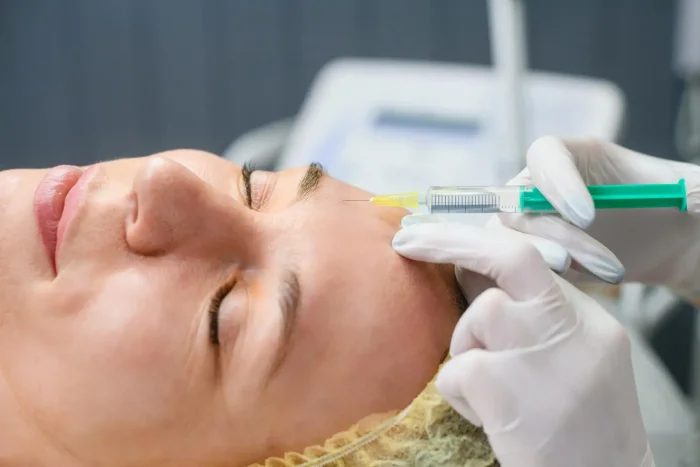Only for Licensed Professionals
Only for Licensed Professionals

Nabota vs Xeomin – Comparing Popular Botulinum Toxins
David Fuller
Last Updated On: June 17, 2024
Botulinum toxin (BoNT) injections are one of the most popular solutions for dynamic wrinkles worldwide. In 2022 alone, over 7.3 million Botox injections were administered globally, making it the top nonsurgical cosmetic procedure in the world.
But beyond Botox, there are various BoNT-A injectables, including Nabota and Xeomin. These neurotoxins share the same active ingredient and treat similar aesthetic concerns. However, subtle differences exist. While both products yield comparable results, Nabota and Xeomin have been compared in terms of neurotoxin protein content and specific potency.
This article delves into the distinctions of Nabota and Xeomin, from their formulation to clinical efficacy, and compares these popular botulinum toxin injections.
Key Takeaways
- Nabota and Xeomin are two widespread botulinum toxins used for various cosmetic and therapeutic indications.
- Xeomin is known for its purified formulation without accessory proteins, setting it apart from other botulinum toxins like Nabota.
- Clinical efficacy and safety profiles are crucial in selecting the appropriate botulinum toxin for specific indications.
- Understanding the pharmacological differences, clinical efficacy, and safety profiles of Nabota and Xeomin is essential for medical experts to make informed treatment decisions.
About: Operating since 2016, Med Supply Solutions is known for being one of the industry’s top and trusted suppliers of cosmetic and viscosupplementation products. If you’re looking to buy Nabota online, contact our sales department for more information.
Understanding Nabota and Xeomin
Nabota and Xeomin are popular botulinum toxin types used in beauty treatments to smooth wrinkles. Nabota is known for its effectiveness and FDA approval (under Jeuveau), making it a trusted choice. On the other hand, Xeomin is celebrated for its purified formulation, containing only botulinum toxin type A without added proteins, which may reduce the risk of allergic reactions.

Both are used to treat various medical conditions. Doctors consider the higher amount of inactive neurotoxin in Nabota versus Xeomin’s more straightforward formula when choosing between them. Real-world studies show minimal differences in safety and efficacy compared to other brands.
Pharmacological Differences
Nabota and Xeomin are distinctive because of their unique ingredients, which differentiate them from similar products.

Nabota and Xeomin are notable botulinum toxins with unique compositions. Xeomin is a purified botulinum toxin type A, free from complex proteins, containing only the essential neurotoxin. Meanwhile, Nabota includes additional proteins with its active ingredient, which can influence the body’s reaction to treatment.
This difference is crucial for medical professionals when choosing between Nabota, Xeomin, Botox, and Dysport for their patients.
Xeomin’s purity is a significant advantage, including proteins. Doctors appreciate this, as fewer proteins can mean fewer reactions. This makes Xeomin unique among treatments. Patients considering options like Nabota may find Xeomin’s straightforward, targeted action appealing.
Clinical Efficacy and Real-World Evidence
Research indicates that both Nabota and Xeomin are effective in reducing the appearance of wrinkles and achieving a smoother skin texture. In a phase III trial comparing Nabota to Botox for essential blepharospasm, Nabota was found to be just as effective and safe as Botox. This supports using Nabota as a viable alternative to Botox for treating critical blepharospasm.

Xeomin has shown similar success to Botox and Nabota in various studies, highlighting its effectiveness. Xeomin has been proven to effectively and safely treat wrinkles on the upper face, including forehead lines, frown lines, and crow’s feet. It’s the first product in a phase III clinical trial to address all these areas at once.

Image courtesy of Phillips Aesthetic Dermatology
The patient experienced a successful treatment using Nabota (AKA Jeuveau) to rejuvenate the forehead area, resulting in longer-lasting effects on unwanted wrinkles.

Image courtesy of Avanti Medical Center
The patient achieved a smooth forehead using Xeomin neurotoxin injections. She received 36 units total: 20 units in her forehead and 16 units between her brows.
Safety Profiles
It’s important to note that Nabota and Xeomin share similar side effects, such as mild pain, swelling, or bruising at the injection site, as well as headaches or feelings of nausea. Professionals administering these treatments should closely follow instructions to avoid dosage errors.
| Aspect | Nabota | Xeomin |
| Key Composition | Contains complexing proteins and similar excipients as Botox | Purified botulinum toxin type A, free of accessory proteins |
| Presence of Inactive Neurotoxin | Greater amounts compared to Xeomin | Free of therapeutically significant complexing proteins |
| Clinical Efficacy | Efficacy in line with other botulinum toxin formulations | Studies show no significant differences in efficacy between Xeomin and Botox |
| Side Effects | Similar to other botulinum toxins, it includes localized pain, swelling, and bruising | Comparable side effects reported cases of eyelid drooping, dry mouth, and headache |
| Unique Consideration | It may require specific handling due to protein content | No refrigeration is needed due to the lack of accessory proteins, simplifying storage |
Practical Considerations for Selecting the Appropriate Botulinum Toxin
Understanding patient characteristics is crucial when selecting between Nabota and Xeomin for botulinum toxin treatments. Nabota is known for its high purity and consistent potency. This treatment is particularly suitable for patients seeking quick results, as it often shows effects within 2 to 3 days.
It is also beneficial for those concerned about developing resistance to botulinum toxins due to its low protein load, which minimizes the risk of antibody formation.
On the other hand, Xeomin is a “naked” botulinum toxin, meaning it contains no accessory proteins. This formulation can benefit patients who have previously developed resistance to other botulinum toxin products or those allergic to specific proteins. Xeomin’s onset of action is generally within 3-4 days, with effects lasting up to 3-4 months.
Dosing and Administration Techniques
Due to their unique formulations, the dosing and administration techniques for Nabota and Xeomin differ slightly. In the Nabota mixing instructions, a typical dilution involves mixing 2.5 mL of saline for every 100 units, resulting in a concentration of 4 units per 0.1 mL. This dilution is then administered using fine needles to target specific muscle groups, ensuring precision and minimizing discomfort.
Xeomin requires a similar dilution process but is often praised for its ease of reconstitution due to the absence of complex proteins. The standard dilution for Xeomin depends on the vial size.
- For a 100-unit or 200-unit vial, Start by reconstituting with 4 mL of preservative-free 0.9% Sodium Chloride Injection, USP. Then, withdraw 4 mL of saline into a syringe for 8 mL. Once done, the specialist can gently mix the 4 mL of Xeomin solution from the reconstituted vial.
- For a 200-unit vial (using 16 mL of diluent): The process is similar to the one mentioned above. However, specialists should withdraw 12 mL of saline into a syringe for 16 mL. They can then gently mix the 4 mL of Xeomin solution from the reconstituted vial.
Nabota and Xeomin should be injected by trained professionals who can tailor the dosage and technique to the patient’s unique facial anatomy and aesthetic goals.
Patient Management for Optimizing Treatment Outcomes
Doctors must manage their patients carefully to get the best results from treatments with Nabota or Xeomin. This involves understanding each patient’s needs and tailoring the treatment accordingly.
- Check the patient’s medical history for allergies or reactions to botulinum toxin products.
- Explain the differences between Nabota and Xeomin, focusing on how each works.
- Discuss the expected outcomes, possible side effects, and recovery time.
- Consider the patient’s goals to decide whether Nabota or Xeomin is better.
- Use accurate dosing to match the patient’s muscle mass and treatment area.
- Inform patients that both products might contain inactive neurotoxins but in different amounts.
- Teach patients about aftercare to minimize side effects.
- Schedule a follow-up visit to assess results and adjust future treatments if needed.
- Keep records of doses used for each treatment area to refine future sessions.
- Stay updated on the latest research comparing Nabota and Xeomin’s safety and efficacy.
Conclusion
Nabota and Xeomin both offer unique benefits for smoothing wrinkles. Xeomin is focused on purity, while Nabota contains extra proteins. Both have shown promising results and safety in studies, providing choices for patients and their beauty goals.
FAQs
1. What is the primary difference between Nabota and Xeomin?
Nabota contains additional proteins, while Xeomin is a pure-form botulinum toxin without added proteins.
2. Is it possible to switch from Nabota to Xeomin easily?
Yes, but consult your doctor before making the switch.
3. How long do the effects of Nabota and Xeomin last?
Both typically last about 3-4 months before fading.
4. Are there any side effects of using Nabota or Xeomin?
Both may have mild side effects, such as swelling or bruising at the injection site.
5. Which works faster, Nabota or Xeomin?
Xeomin may begin working slightly faster than Nabota in some cases.
References
Top nonsurgical cosmetic procedures globally 2019. Statista. https://www.statista.com/statistics/293449/leading-nonsurgical-cosmetic-procedures/
Kim D, Kim J. Safety and Efficacy of PrabotulinumtoxinA (Nabota®) Injection for Cervical and Shoulder Girdle Myofascial Pain Syndrome: A Pilot Study. Toxins. 2018;10(9):355. doi:https://doi.org/10.3390/toxins10090355
Reconstitution, dilution, and storage | XEOMIN®. https://www.xeomin.com/healthcare-professionals/reconstitution-and-storage
Products
Cart
Log In
Newsletter
Subscribe for exclusive offers and updates on new arrivals
Share feedback at:
Working Hours
MON - SUN 9AM to 6PM EST
The Most Popular Brands
Med Supply Solutions
Support
Secure checkout is guaranteed with full adherence to PCI DSS payment standards.
Products listed here are guaranteed authentic and manufacturer-sourced.
Pay easily with trusted providers


*Google and Apple Pay are currently only available via a direct link provided by your account manager.
Copyright 2025. Med Supply Solutions